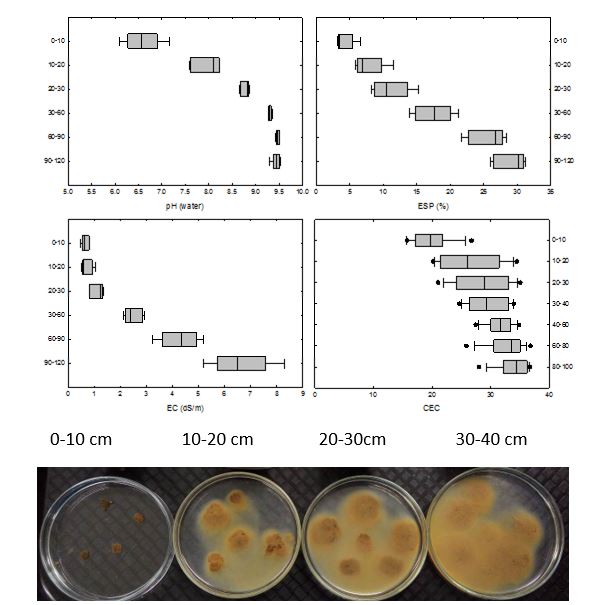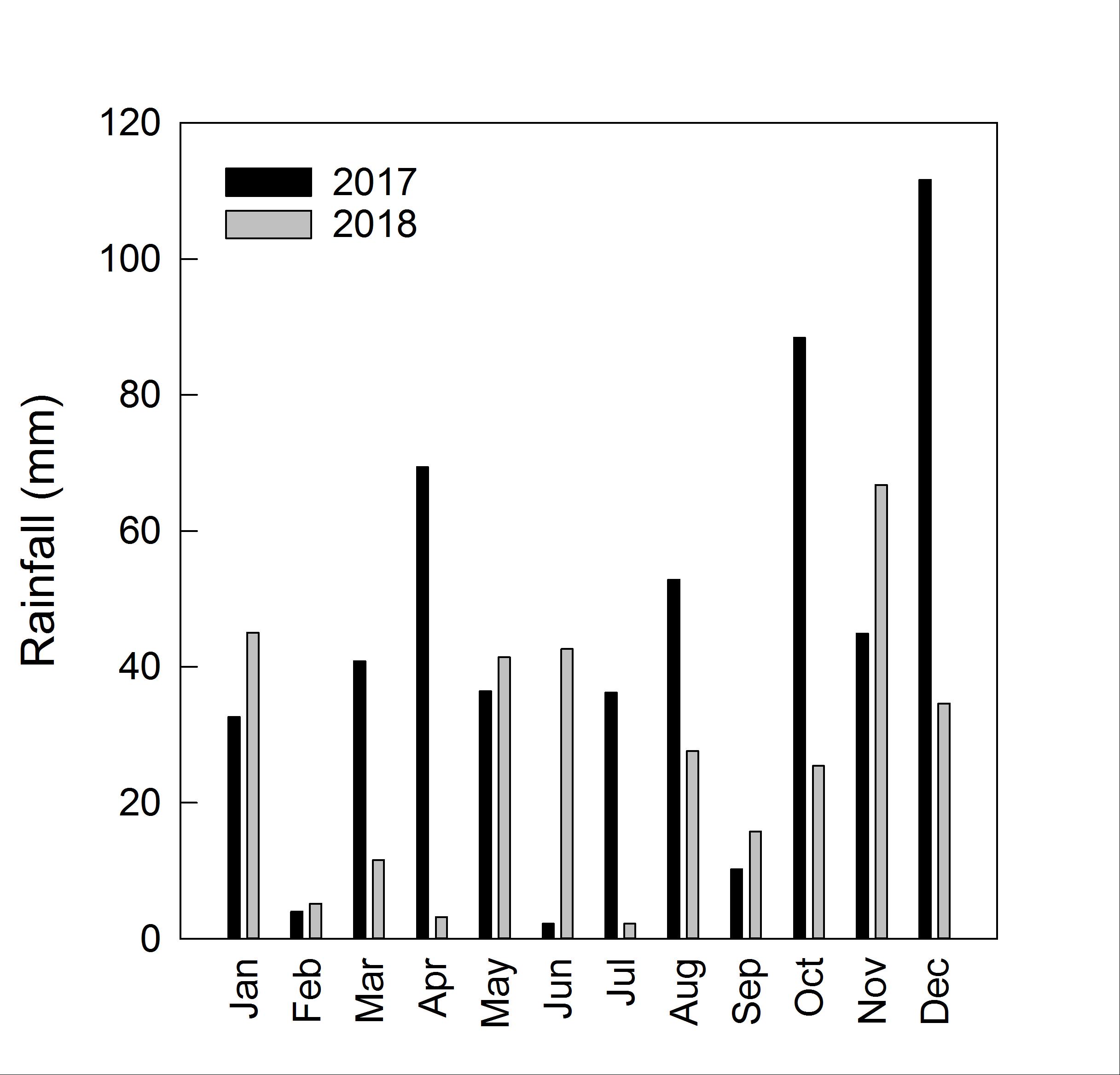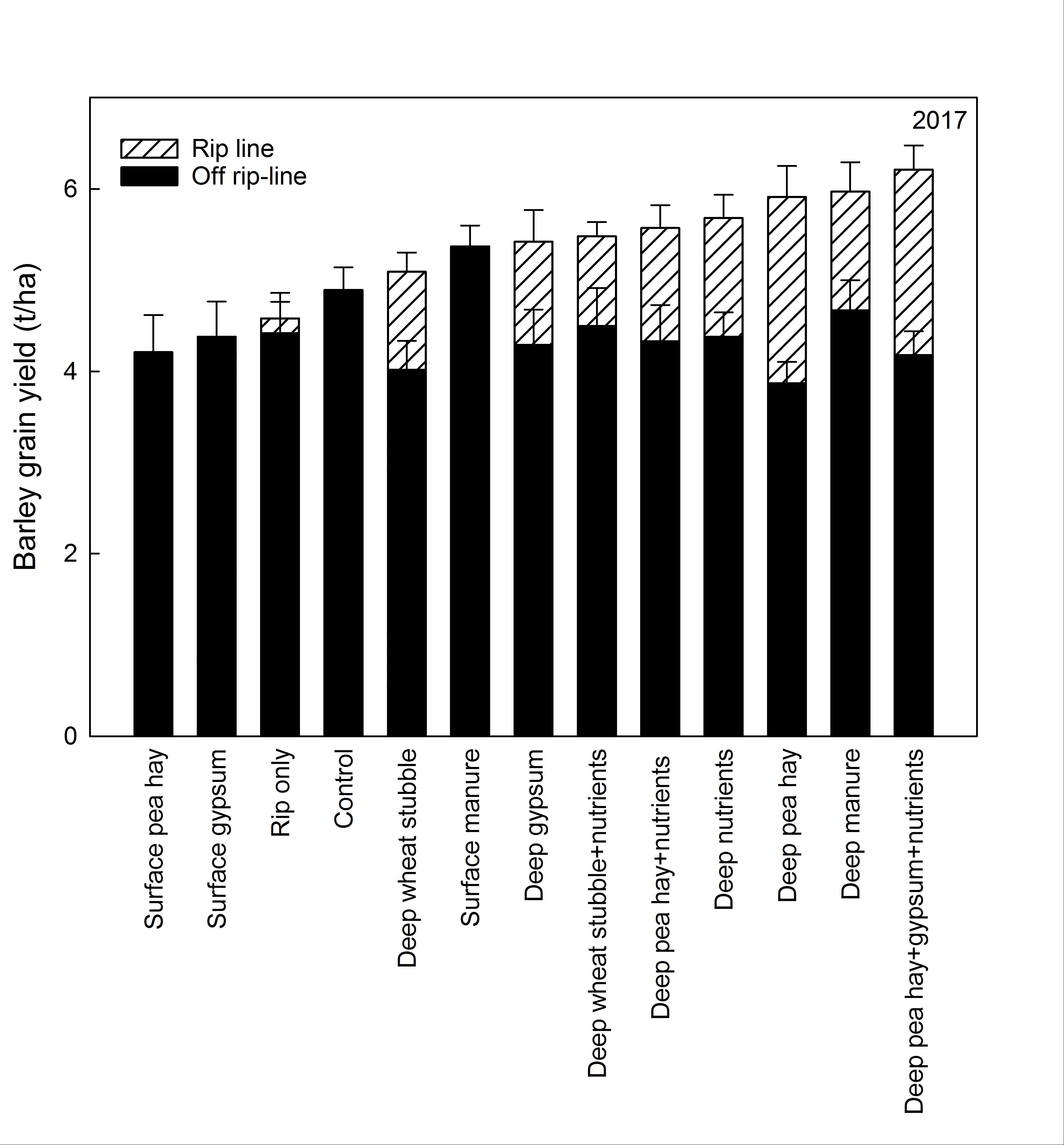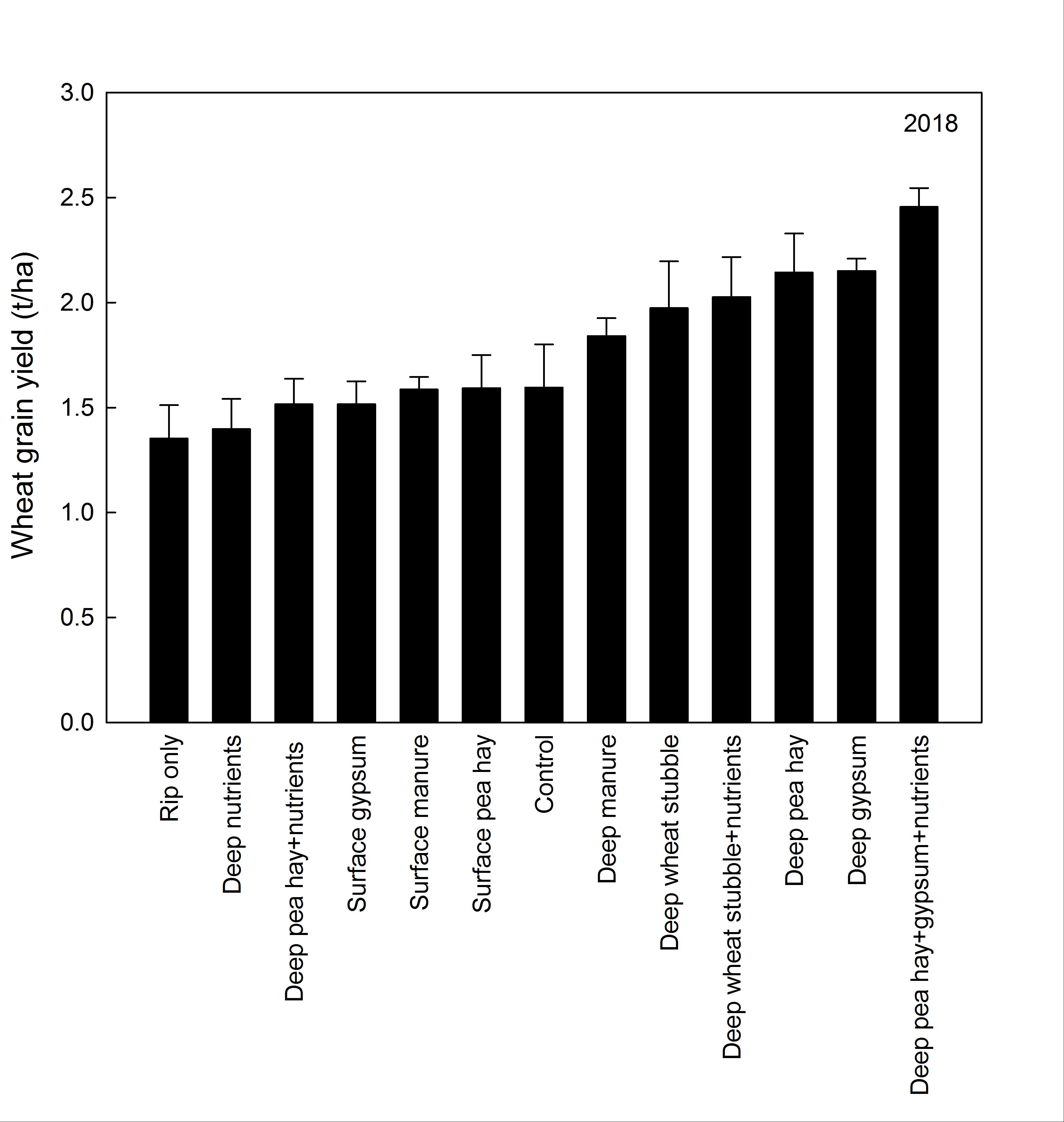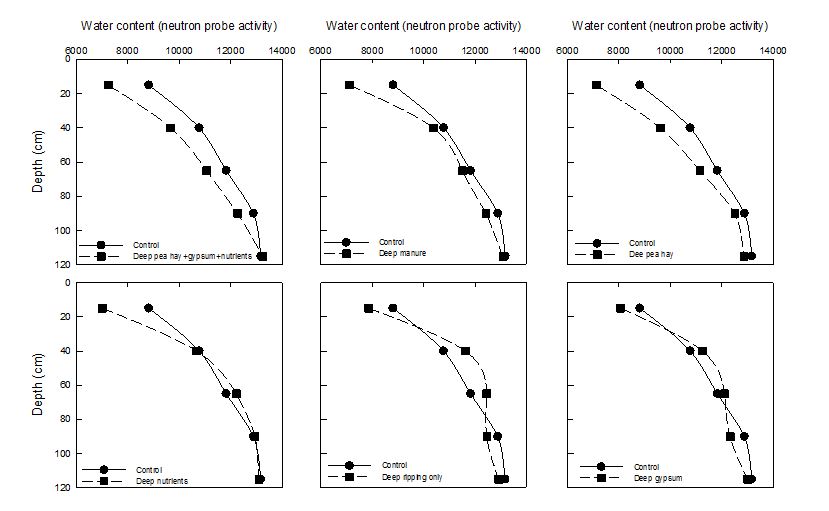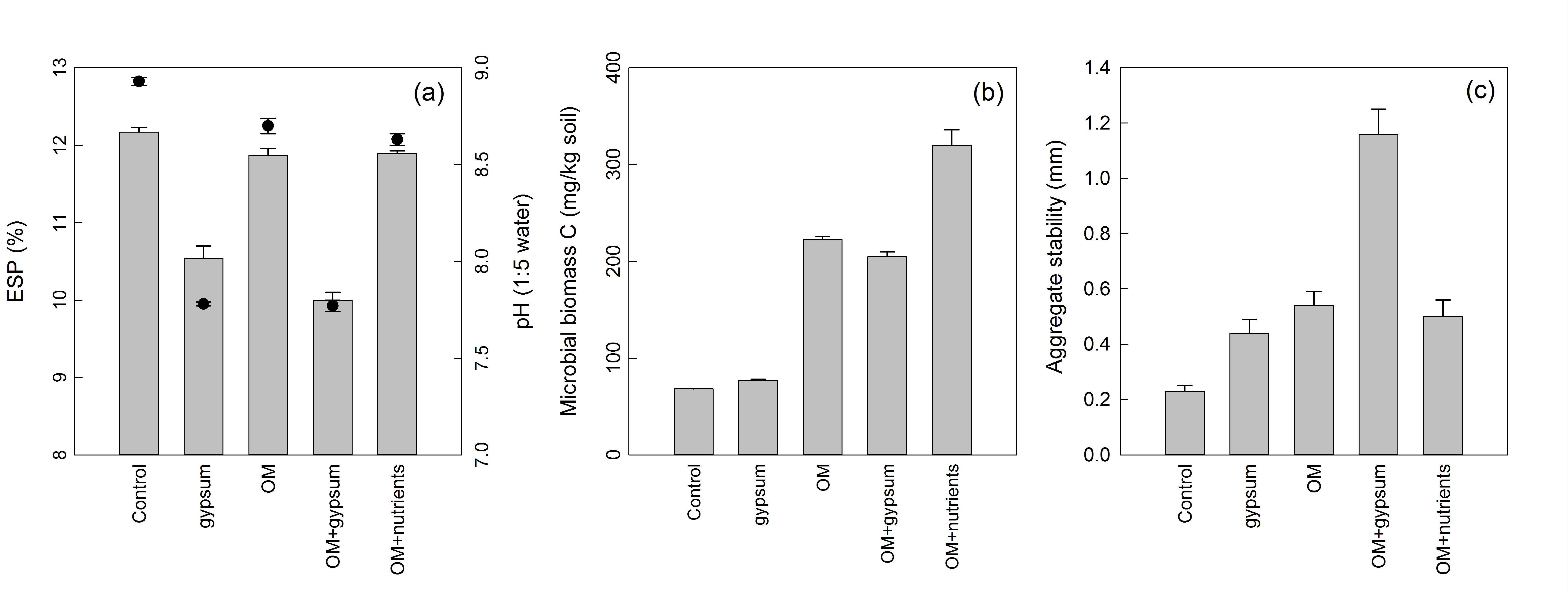Understanding the amelioration processes of the subsoil application of amendments
Take home messages
- The early results of this project showed great potential in improving soil structure and crop productivity in sodic subsoils using deep placement of organic and inorganic amendments. The increases resulted from improvement in the physical and chemical properties of the clay soil volume around the rip line containing the organic and inorganic amendments, and from increased root growth through the subsurface soil layers adjacent to the rip lines. This improvement was possibly mediated by increased microbial activity that leads to improved soil aggregation.
- In both years of the field experiment, the greatest yield response was achieved in the pea hay + gypsum + nutrients treatment. Given multiple subsoil constraints including high pH, sodicity and poor soil structure that exist in south-east Australia, an amendment with multiple modes of action is required to improve hostile subsoils.
- It is proposed that a reduction in net dispersive charge and pH together with an enhanced microbial biomass carbon (C) resulted in improved soil aggregation. The changes in soil chemicophysical properties correlated with higher crop water uptake from the ameliorated layer.
Background
Approximately 75% of Australian soils have subsoil constraints that limit agricultural productivity. The major constraints to crop growth are poorly structured subsoils that result from high clay content and bulk density, as well as the presence of high subsoil exchangeable sodium (Na) concentrations (resulting in soils with poor subsoil structure, impeded drainage, waterlogging, and high soil strength). These constraints adversely affect soil water and plant available water content (PAWC) by impeding water entry into the soil, restricting water movement within the soil, reducing the soil’s ability to store water and nutrients, and reducing the ability of plants to access and extract stored water and nutrients. Soil constraints may be multiple or singular, occurring either near the soil surface, or in the subsoil and they tend to be highly variable across any given paddock or property (McDonaldet al. 2013).
A range of practices including deep ripping, subsoil manuring, clay incorporation, applying gypsum, installing underground drainage or use of ‘primer-crops’ have been tested to overcome subsoil constraints, usually with unreliable results and often potential financial losses to growers (Gillet al. 2008). For example, despite the fact that gypsum is widely used as the main soil amendment in improving poor structure of sodic soils, it is a sparingly soluble salt and because of this attribute it is hardly possible to deliver adequate calcium (Ca) to correct sodicity issues in the subsoil. In regards to subsoil manuring, despite the demonstrated step change in crop yields that can be achieved by this management strategy, practice change in the grains industry to date has been limited. One constraint to widespread adoption includes the local availability and high cost of suitable organic ameliorants delivered in-paddock. This factor can be significant as research to date in the higher rainfall zones suggests rates of up to 20t/ha are required — transport costs quickly become prohibitive if this material needs to be sourced off-farm (Gillet al. 2008; Saleet al. 2019). Therefore, solutions integrating complementary sources of organic matter materials, such as crop residue and cover crop biomass produced in-situ, need to be investigated, with current project DAV00149 initiating this new area of research.
A series of field and glasshouse experiments was established to understand the amelioration process when various organic and inorganic amendments are placed at depth in dispersive subsoils. This paper will provide results of a GRDC project (DAV00149) aiming to ameliorate subsoil constraints and to understand the amelioration processes of the subsoil application of amendments. It will show how deep incorporation of organic amendments into the clay subsoil provided significant improvements in grain yield, which was associated with changes in subsoil properties and improved root growth.
Method
Field trial
The two-year field experiment was established on a farm in Rand, southern NSW, in February 2017. The site was located in a paddock that had been cropped with a cereal-canola rotation for more than 50 years. Selected soil properties collected from the untreated soil are presented in Table 1. The soil is a Sodosol (Isbell, 2002), with a texture-contrast profile increasing in clay content at depth. The physical and chemical properties indicate that the subsoil condition was unfavourable for root growth. The high clay content in this subsoil layer has a bulk density of 1.55g/cm3 that restricts water movement, and consequently the saturated hydraulic conductivity value is low at 0.03cm/hr (Table 1).
The experimental plots were 2.5m wide and 20m long. There were 14 treatments comprising 1) the control, 2) surface application of gypsum, 3) surface application of chicken manure, 4) surface application of pea hay, 5) deep ripping, 6) deep placement of gypsum, 7) deep placement of manure, 8) deep placement of wheat stubble, 9) deep placement of wheat stubble + nutrients, 10) deep placement of pea hay, 11) deep placement of biochar, 12) deep placement of pea hay + nutrients, 13) deep placement of liquid nutrients, and 14) deep placement of pea hay + gypsum + nutrients. The experiment was a randomised complete block design with four replicates.Ripping and subsoil incorporation treatments were carried out with a 3-D ripping machine (NSW DPI). The machine can deliver inorganic and/or organic amendments at two depths from 10cm to 30cm. The machine is also capable of delivering liquid nutrients/fertilisers at depth. The experiment at Rand was sown to barley (cv. La Trobe) on 18 May 2017 and wheat (cv. Lancer) on 15 May 2018.
A Geonics EM38® instrument in vertical dipole mode was used to measure the apparent electrical conductivity (ECa) of the soil. Based on the map of ECa, the most uniform area of each field was selected for the experiments. The experiment was direct sown using DBS tynes spaced at 250mm. At sowing, 80kg monoammonium phosphate (MAP) (18kgphosphorus (P)/ha and 8kg nitrogen (N)/ha) was added to all plots. Pre-crop weed control was undertaken by applying Roundup® at 1.5L/ha, as well as the pre-emergents Sakura® (pyroxasulfone 850g/L) at 118g/ha and Logran® (triasulfuron 750g/L) at 35g/ha, and was incorporated at sowing. Precautionary disease control was implemented, seed was treated with Hombre ®Ultra imidacloprid (360g/L) and tebuconazole (12.5g/L)] at 200mLs/100kg and Prosaro® (prothioconazole 210g/L and tebuconazole 210g/L) was applied at 300mL/ha at DC 31. The experiment was harvested on 1 December. Grain protein and seed quality were estimated using near infrared (NIR) (Foss Infratec 1241 Grain Analyzer) and seed imaging (SeedCount SC5000R), respectively. At anthesis, about 50 youngest fully mature leaves (YML) were obtained randomly from each replicate plot of each genotype and then dried at 70◦C for 48 hours. Dried plant samples were digested in an acid mixture of nitric and perchloric acid and concentrations of ions were measured on inductively coupled plasma (ICP).
Incubation experiment
To provide further insights into the dynamics of C mineralisation and the interactive effects of organic amendments and gypsum, a laboratory based incubation experiment was conducted. The soil (450g air-dried soil, equivalent to 430g oven-dried soil) was uniformly mixed with organic amendments (i.e.crop stubble) at an application rate of 6.2g C/kg soil with or without gypsum (CaSO4·2H2O) of 7.2g/kg soil or nutrients. The soils were incubated for 90 days and the changes in soil pH, exchangeable Na%, microbial biomass C and aggregate stability were then measured.
Results and discussion
Soil constraints and weather
The depth-wise distribution of physicochemical soil constraints are shown in Figure 1. The profile is characterised by the soil pH ranges from 5.1-9.1 with increasing sodicity (ESP up to 30%) with depth. A dispersion test was performed on several aggregates and indicated significant dispersion in subsoil increasing with depth (Figure 1). A considerable amount of soil water below 60cm was found after harvest which suggests limitations to root growth reduced the ability of the crop to access subsoil water (Rengasamyet al. 2016).
Figure 1. Soil characteristics of sodic site in Rand (southern NSW). Various lines indicate multiple locations across the trial. The picture shows the assessment of soil dispersion at four different depths. The increasing levels of exchangeable Na relative to calcium (Ca) and/or magnesium (Mg) in subsoil result in a decrease in soil structural stability and higher dispersion as shown above. When dispersion occurs, the dispersed clay particles fill up the pores between soil particles and aggregates, and when the soil dries out, the dispersed clay blocks soil pores. This can restrict seedling emergence, water and air movement, and root penetration. Dispersed soils are generally hard-setting and may form a surface crust or concrete-like lump which can also result in waterlogging.
The growing season rainfall in 2017 and 2018 was 329mm and 225mm, respectively. In 2017, rainfall during the April to November growing season was 62.5mm less than the long term average, whereas in 2018, it was 178mm less than the average rainfall. The average rainfall in 2018 was about 40% lower than 2017 (Figure 2).
Figure 2. Mean monthly rainfall (histogram) and mean monthly air temperatures at the experimental site (Rand) in southern NSW in 2017 and 2018.
Yield response to different amendments
This experiment established in 2017 showed consistent, significant (P<0.05) effects of amendment on grain yield in two consecutive years (Figures 3 and 4). In 2017, each plot with deep placement of amendments was harvested in two locations. These were on the amended rip line and off the amended rip line. This approach was undertaken based on the field observations of differential responses between crop rows on and off rip lines. While there was no significant difference (P>0.05) between the control and yield response off the amended rip line, a marked positive response was achieved for crop harvested on the amended rip line. Compared with the control treatment, the highest increase (P<0.05) in grain yield was observed for deep placement of pea hay + gypsum + nutrient (27%), followed by deep placement of manure (22%) and pea hay (20%). As a main effect, rip only, surface gypsum and surface pea hay treatments yielded 6%, 10% and 13% less than control treatments (Figure 3).
Figure 3. The effects of surface or deep placed amendments on grain yield of La Trobe barley in 2017 at Rand, southern NSW. Plots with deep placement treatments were harvested on amended rip lines (dashed bars, on rip line) and off unamended rip lines (black bars, off-rip line). Values are averages (n = 4).
In the 2018 season, wheat grain yield significantly (P<0.05) increased 27%-53% (compared with the control) following amendment application in 2017 (Figure 4). The highest increase was observed for deep placement of pea hay + gypsum + nutrient treatment (53%), followed by deep placement of gypsum (34%), pea hay (34%) and deep wheat stubble + nutrients (27%). As a main effect, surface pea hay, surface manure, surface gypsum, deep pea hay + nutrients, deep nutrients and rip only treatments yielded 0.1%-15% less than the control. These differences were not significant (P>0.05).
Figure 4. The effects of surface or deep placed amendments on grain yield (whole plot) of Lancer wheat in 2018 at Rand, southern NSW. Values are averages (n = 4).
The volumetric water content in the soil declined in all layers of the profile as the wheat crop matured some 200 days after sowing (2018 growing season). A number of variations in the pattern of the decline in soil water were observed in different subsoil amelioration treatments. The most notable result occurred with the deep pea hay + gypsum + nutrients treatment followed by deep manure and deep pea hay, where there was a marked drying of the ameliorated layers as the crop matured (Figure 5). The effect was observed in the 40cm-60cm (amended layer). The neutron probe values in this layer were significantly lower (P<0.05) for the organic amendment treatments at crop maturity than for all other treatments including the control, the deep ripped, deep nutrients and the deep gypsum treatments (Figure 5).
Figure 5. The changes in soil water content in various treatments compared with the control at the Rand site in 2018. Results are based on the neutron activity (raw data), where higher values represent higher water content in the soil profile. Values are averages (n = 4).
Control | Deep gypsum | Deep nutrients | Deep manure | Deep pea hay | Deep pea+ gyp+ nutrients | rip only | |
|---|---|---|---|---|---|---|---|
ESP (%) | |||||||
0-10 | 5.89 | 7.00 | 6.43 | 7.89 | 6.09 | 5.13 | 7.23 |
10-20 | 8.47 | 8.18 | 9.11 | 11.41 | 8.33 | 6.01 | 9.69 |
20-30 | 13.35 | 11.70 | 12.59 | 16.24 | 12.91 | 9.68 | 14.09 |
pH (1:5 water) | |||||||
0-10 | 6.61 | 6.96 | 7.04 | 6.37 | 6.87 | 6.89 | 6.86 |
10-20 | 7.98 | 7.77 | 7.99 | 7.66 | 7.76 | 7.69 | 7.91 |
20-30 | 8.99 | 8.13 | 8.96 | 8.60 | 8.87 | 8.38 | 8.94 |
Table 1 shows the effect of various amendments on soil ESP and pH at three depths. The deep placement of amendments at a depth of 15-40cm had a marked impact on the physicochemical properties in the subsoil layers. The 20-30cm deep subsoil layer in the control treatment had a pH of 9 and ESP of 13.4%. Deep placement of gypsum, pea hay + gypsum + nutrients and deep manure reduced the soil pH by 0.86, 0.61 and 0.39 unit, respectively (P<0.05). Compared with the control, the deep placement of gypsum and pea hay + gypsum + nutrients treatments also reduced the ESPby 12% and 27%.
To further explore the changes that organic amendments have on subsoil physical and chemical properties, primarily the effects on water-stable aggregates, an incubation experiment was conducted to investigate how the physical condition of the sodic clay soil may benefit from the addition of organic amendments that are able to benefit biological activity in the soil. Figure 6 shows the effects of gypsum, organic matter (crop stubble), organic matter + gypsum and organic matter + nutrients after an incubation of 90 days on the formation of water-stable aggregates. Similar to data from field trials, gypsum had a significant effect (P<0.05) on reducing soil pH (1.15 unit) and ESP (13%-17%) compared with the control. The addition of organic matter with or without nutrients had no influence on soil pH or ESP. However, the input of organic matter and organic matter + nutrient increased total microbial biomass C by 3-fold and 4.7-fold, respectively (P<0.05). Combined application of organic matter (OM) and gypsum had the greatest influence on the proportion of stable aggregates in the poorly structured sodic alkaline subsoil used in this study. While separate application of gypsum and OM increased the aggregate stability, the much greater improvement in soil aggregation in OM + gypsum treatment suggests that their co-application has an additive and/or interactive effect.
Figure 6. The effect of gypsum, OM, OM + gypsum and OM + nutrients on (a) soil ESP (bars) and pH (˜), (b) microbial biomass C (mg/kg soil) and (c) aggregate stability (mm) over the 90-day incubation period. Error bars represent ± standard errors of the mean (n = 4).
Discussion
This study provides early but significant indications that soil amelioration of alkaline-sodic subsoils with organic and inorganic amendments can provide significant grain yield increases that are associated with both improved soil chemicophysical properties and water use.
The extent of the changes in soil chemical and physical properties in the 15cm-40cm layers of this alkaline sodic soil, with the deep incorporation of organic and inorganic amendments, was remarkable. The changes occurred over the 14-month period between the incorporation of the amendments in late February 2017, and the taking of soil samples in May 2018. The key changes were a reduction in subsoil pH and ESP (Table 1) and an increase in soil porosity (data not shown) and higher water uptake by the crop (Figure 5). While the soil analysis is still in progress, it is suggested that this is resulted from improved soil aggregation, as incubation studies using this clay subsoil and similar organic amendments, led to a rapid improved aggregation in the clay matrix over three months (Figure 6).
The results demonstrated that amelioration of multiple soil constraints (high pH, sodicity and poorly structured aggregates) requires amendments and strategies with various modes of action and independent mechanisms. The suggested improvement in subsoil aggregation with OM + gypsum and the resulting significant increases in grain yield in this study can be attributed to several causes. The first was that application of gypsum resulted in a reduction in pH of 0.86-1.15 unit (Table 1, Figure 5). Tavakkoli et al. (2015) showed that carbonate salts of Na and potassium (K) dominate above pH 8.5 of many sodic subsoils in south-east Australia and a reduction in pH below 8.5 can decrease the net dispersive charge and ESP by changing the speciation of carbonate salts (Rengasamyet al. 2016). The second reason for the suggested improvement in subsoil aggregation was that the organic amendments provide a substrate for greatly enhanced microbial activity in and around the rip lines. The incubation study discussed above also found that the addition of OM to alkaline sodic, clay subsoil increased microbial biomass C over the 90 day of incubation period which in turn led to rapid improvement in aggregation (Clarket al. 2007; Gill et al. 2008; Fanget al. 2018).
Conclusions
The findings from this study demonstrate early results for amelioration of alkaline sodic subsoils in southern NSW. Deep application of organic and inorganic amendments resulted in significant yield increases in 2017 and 2018. The increases resulted from the improvement in the chemical and physical properties of the subsoil around the rip line containing the organic and inorganic amendments. This improvement was mediated by a reduction in soil pH and ESP and an increased microbial activity that leads to improved soil aggregation. This led to considerable water extraction from the deeper clay layers.
References
Clark, G.J., Dodgshun, N., Sale, P.W.G. & Tang, C. 2007. Changes in chemical and biological properties of a sodic clay subsoil with addition of organic amendments. Soil Biology and Biochemistry, 39, 2806-2817.
Fang, Y., Singh, B.P., Collins, D., Li, B., Zhu, J. & Tavakkoli, E. 2018. Nutrient supply enhanced wheat residue-carbon mineralization, microbial growth, and microbial carbon-use efficiency when residues were supplied at high rate in contrasting soils. Soil Biology and Biochemistry, 126, 168-178.
Gill, J.S., Sale, P.W.G. & Tang, C. 2008. Amelioration of dense sodic subsoil using organic amendments increases wheat yield more than using gypsum in a high rainfall zone of southern Australia. Field Crops Research, 107, 265-275.
Isbell, R.F. 2002. The Australian Soil Classification. CSIRO, Melbourne.
Kirkegaard, J.A., Lilley, J.M., Howe, G.N. & Graham, J.M. 2007. Impact of subsoil water use on wheat yield. Australian Journal of Agricultural Research, 58, 303-315.
McDonald, G.K., Taylor, J.D., Verbyla, A. & Kuchel, H. 2013. Assessing the importance of subsoil constraints to yield of wheat and its implications for yield improvement. Crop and pasture science, 63, 1043-1065.
Rengasamy, P., Tavakkoli, E. & McDonald, G.K. 2016. Exchangeable cations and clay dispersion: net dispersive charge, a new concept for dispersive soil. European Journal of Soil Science, 67, 659-665.
Sale, P.W., Gill, J.S., Peries, R.R. & Tang, C. 2019. Crop responses to subsoil manuring. I. Results in south-western Victoria from 2009 to 2012. Crop and pasture science, 70, 44-54.
Tavakkoli, E., Rengasamy, P., Smith, E. & McDonald, G.K. 2015. The effect of cation–anion interactions on soil pH and solubility of organic carbon. European Journal of Soil Science, 66, 1054-1062.
Acknowledgments
The research undertaken as part of this project is made possible by the significant contributions of growers through both trial cooperation and the support of the GRDC — the author would like to thank them for their continued support. This research was undertaken as part of project DAV00149.
Contact details
Ehsan Tavakkoli
NSW DPI, Wagga Wagga Agricultural Institute
02 69381992
Ehsan.tavakkoli@dpi.nsw.gov.au
@EhsanTavakkoli
GRDC Project Code: DAV00149,
Was this page helpful?
YOUR FEEDBACK

